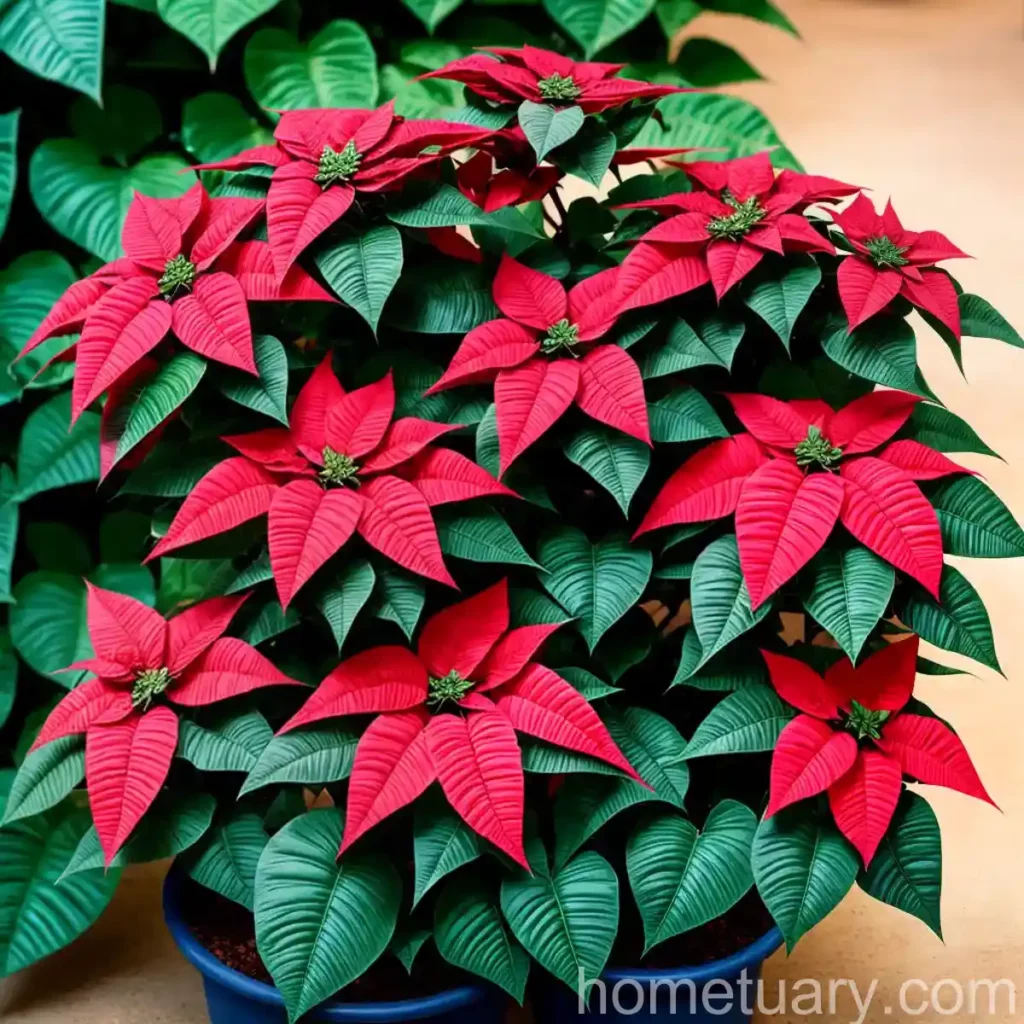Poinsettia (Euphorbia pulcherrima): A Detailed Guide to Cultivation and Care
Poinsettia (Euphorbia pulcherrima) is a well-known ornamental plant that is prominently featured during the festive season. Its colorful bracts and cultural importance make it a popular choice for holiday decorations. As a plant scientist, I’m excited to delve into the intricacies of poinsettia cultivation, its uses, care requirements, and interesting facts.
What is Poinsettia (Euphorbia pulcherrima)?
Poinsettia, scientifically known as Euphorbia pulcherrima, is a species of flowering plant indigenous to Mexico. The plant was introduced to the United States by Joel Roberts Poinsett, the first US Minister to Mexico, and it is from his surname that it derives its common name. The colorful “flowers” of the poinsettia are actually modified leaves known as bracts, which surround the small yellow flowers in the center. These bracts come in various shades of red, pink, white, and marbled patterns, adding to the plant’s visual appeal.
Key Takeaways – Poinsettia (Euphorbia pulcherrima)
Before we delve into the intricacies of poinsettia care, let’s look at some key takeaways that will be covered in this comprehensive guide:
– Culture of Poinsettia
– Uses of Poinsettia
– Watering Requirements
– Sunlight Preferences
– Fertilization Needs
– Soil Considerations
– Pruning Techniques
– Propagation Methods
– Container Gardening
– Popularity of Poinsettia
– Common Pests and Diseases
– Diagnosis and Control Measures
– Fun Facts about Poinsettia
Now that we have an overview, let’s dive into the details!
Culture of Poinsettia
Understanding the cultural requirements of poinsettia is essential to ensure its healthy growth and vibrant bracts. Proper culture encompasses various aspects such as planting, watering, sunlight, and soil conditions.
Uses
Poinsettias are primarily used for decorative purposes, especially during the festive season. They are often utilized as ornamental elements in homes, offices, and public spaces. Furthermore, they are popular as gifts or centerpieces, adding a festive and cheerful touch to any environment.
Water
One of the critical aspects of poinsettia care is proper watering. Overwatering or underwatering can have adverse effects on the plant’s health and blooming. It is important to strike a balance and ensure that the soil is neither too dry nor waterlogged.
Sunlight
Poinsettias thrive in bright, indirect light. While they require a minimum of six hours of indirect sunlight daily, excessive exposure to direct sunlight should be avoided. Prolonged exposure to direct sunlight can cause the bracts to fade and the plant to wilt.
Fertilizer
Proper fertilization is crucial for poinsettias, especially during their active growing period. A well-balanced, water-soluble fertilizer should be applied according to the instructions provided. Over-fertilization can be detrimental, so it’s important to adhere to the recommended guidelines.
Soil
The soil should have good drainage properties to prevent waterlogging, which can lead to root rot. A well-draining potting mix with a slightly acidic pH is well-suited for poinsettias. Additionally, amending the soil with organic matter can enhance its overall quality and drainage.
Pruning
Pruning is essential for maintaining the desired shape and promoting bushy growth in poinsettias. It is typically performed in late winter or early spring, and the plant should be pruned back to encourage new growth. Proper pruning techniques are crucial to prevent damage to the plant.
Propagation
Poinsettias can be propagated through stem cuttings. Selecting healthy, non-flowering stems and providing them with the optimal conditions for root development can result in successful propagation. This allows for the expansion of poinsettia populations and the cultivation of unique varieties.
Container
Cultivating poinsettias in containers offers flexibility and ease of maintenance, making them suitable for both indoor and outdoor environments. Selecting well-draining pots of appropriate size and maintaining a suitable indoor environment ensures healthy growth and flourishing bracts.
Popularity
The popularity of poinsettias is attributed to their vibrant bracts and cultural significance. Their association with the holiday season, coupled with their striking appearance, has positioned them as one of the most sought-after ornamental plants during festive celebrations.
Common Diseases
Poinsettias are susceptible to certain diseases that can affect their overall health and appearance. Identifying these diseases and implementing appropriate control measures is essential to safeguard the plants against potential damage.
Disease Diagnosis
Diagnosing poinsettia diseases involves recognizing symptoms such as leaf spots, wilting, and abnormal discoloration. Understanding the underlying causes and implementing targeted treatments is crucial for disease management.
Common Pests
Pests can pose a threat to poinsettias, affecting their growth and vitality. Identifying common pests and adopting suitable pest control measures is imperative to ensure the plants remain pest-free.
Botanist’s Tips
As a botanist, I’ve compiled a set of recommendations to effectively care for poinsettias and address common problems associated with their cultivation. These tips are derived from years of experience and a deep understanding of plant physiology.
Fun Facts
Poinsettias are not only known for their ornamental beauty but also for their intriguing history and characteristics. Here are some fascinating fun facts about poinsettias that add to their allure.
Links to External Resources
To supplement this comprehensive guide, here are some valuable external resources that provide further insights into poinsettia cultivation and care:
– University of Florida IFAS Extension: Poinsettias
– The Ohio State University: Poinsettia Pointers
With these resources, you can enhance your understanding of poinsettia cultivation and address specific queries related to their care.
In conclusion, poinsettias are not only visually captivating but also hold significant cultural and traditional importance. Blending proper care techniques with an appreciation for their historical significance enhances the overall experience of cultivating and enjoying these iconic plants.
I hope this comprehensive guide provides you with valuable insights into the world of poinsettias and equips you with the knowledge to foster their health and beauty.
Happy gardening!















